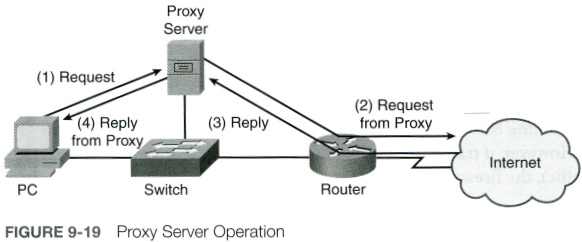
Some clients are configured to forward their packets, which are seemingly destined for the Internet, to a proxy server. The proxy server receives the client's request, and on behalf of that client (that is, as that client's proxy), the proxy server sends the request out to the Internet. When a reply is received from the Internet, the proxy server forwards the response on to the client. Figure 9-19 illustrates the operation of a proxy server.
What possible benefit could come from such an arrangement? Security is one benefit. Specifically, because all requests going to the Internet are sourced from the proxy server, the IP addresses of network devices inside the trusted network are hidden from the Internet.
Yet another benefit could come in the form of bandwidth savings because many proxy servers perform content caching. For example, without a proxy server, if multiple clients all visited the same website, the same graphics from the home page of the website would be downloaded multiple times (one time for each client visiting the website). However, with a proxy server performing content caching, when the first client navigates to a website on the Internet, and the Internet-based web server returns its content, the proxy server not only forwards this content to the client requesting the web page but also stores a copy of the content on its hard drive. Then, when a subsequent client points its web browser to the same website, after the proxy server determines that the page has not changed, the proxy server can locally server up the content to the client, without having to once again consume Internet bandwidth to download all the graphics elements from the Internet-based website.
As a final example of a proxy server benefit, some proxy servers can perform content filtering to restrict clients from accessing certain URLs. For example, many companies use content filtering to prevent their employees from accessing popular social networking sites and promote productivity.
Note: A reverse proxy receives requests on behalf of a server and replies back to the clients on behalf of those servers. Reverse proxies can also be used with load-balancing and caching to better utilize a group of servers providing scalability and high availability.
About The Author
Anthony Sequeira, CCIE No. 15626, is a Cisco Certified Systems Instructor (CCSI) and author regarding all levels and tracks of Cisco Certification. Anthony formally began his career in the information technology industry in 1994 with IBM in Tampa, Florida. He quickly formed his own computer consultancy, Computer Solutions, and then discovered his true passion-teaching and writing about Microsoft and Cisco technologies. Anthony joined Mastering Computers in 1996 and lectured to massive audiences around the world about the latest in computer technologies. Mastering Computers became the revolutionary online training company, KnowledgeNet, and Anthony trained there for many years. Anthony is currently pursuing his second CCIE in the area of Security and is a full-time instructor for the next-generation of KnowledgeNet, StormWind.com. Anthony is also a VMware Certified Professional.
CompTIA Network+ N10-008 Cert Guide contains proven study features that allow you to succeed on the exam the first time. Expert instructor Anthony Sequeira shares preparation hints and test-taking tips, helping you identify areas of weakness and improve both your conceptual knowledge and hands-on skills, essential for successful completion of the performance-based testing items on the exam. This complete, CompTIA-approved study package includes the following:
• A test-preparation routine proven to help you pass the exams
• Clearly defined chapter learning objectives covering all N10-008 exam topics
• Chapter-ending review questions and exam preparation exercises, which help you drill on key concepts you must know thoroughly
• The powerful Pearson Test Prep practice test software, complete with hundreds of well-reviewed, exam-realistic questions, customization options, and detailed performance reports
• 40 performance-based exercises to help you prepare for the hands-on exam questions
• A free copy of the CompTIA Network+ N10-008 Simulator Lite software, complete with meaningful lab exercises that enhance your hands-on skills
• More than 60 minutes of video mentoring
• A final preparation chapter that guides you through tools and resources to help you craft your review and test taking strategies
• An Exam Essentials appendix that quickly recaps all major chapter topics for easy reference, both in print and interactive digital format
• A key terms Glossary in both print and on the companion website, which acts as an interactive flash-card application
• Study plan suggestions and templates to help you organize and optimize your study time
• A 10% exam discount voucher (a $33+ value!)
Well regarded for its level of detail, study plans, assessment features, challenging review questions and exercises, video instruction, and hands-on labs, this approved study guide helps you master the concepts and techniques that ensure your exam success.
Master the topics on the CompTIA Network+ N10-008 exam, including:
• Network topologies and media types
• IP addressing
• Network services
• Data center architectures and cloud concepts
• Routing, Ethernet switching, and wireless networking
• Network availability and disaster recovery
• Network security
• Remote access
• Network troubleshooting
Learn more about the CompTIA Network+ N10-008 Cert Guide at amazon.com
More Networking Topologies Articles:
• Hubs, Switches and Routers - What's the Difference?
• Static Versus Dynamic Routing
• Data Center Management Best Practices
• VLAN (Virtual Local Area Network) Basics
• Understanding the Basics of All-Optical Switching
• Wireless Network Vlans - How to Implement Wireless Vlans
• Wireless Networking
• The Difference Between a Broadcast Domain and a Collision Domain
• Proxy Servers
• How to Choose the Proper Fiber Optic Connector for Your FTTH (Fiber To The Home) Installation



